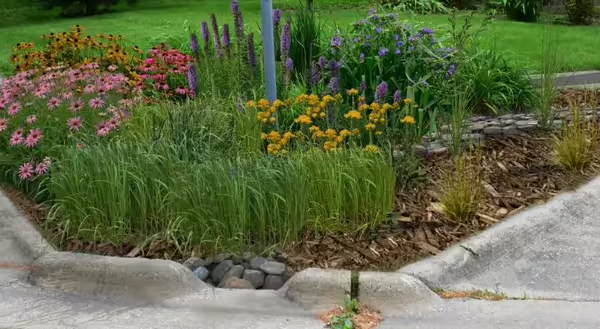
Many of us are willing to do something different with our front yards if it results in a positive environmental impact, according to a survey by the Extension CED Sustainable Communities team.
We asked people about putting rain gardens in their right of ways. These are gardens, between the sidewalk and the street in residential neighborhoods, designed to catch rainwater from houses, sidewalks, and driveways before it gets to the storm sewer. These gardens can reduce street and basement flooding and keep some pollutants from roofs and lawns out of rivers and lakes.
Over 80% of survey respondents said they would like to have a rain garden in their right of way.
People said they liked the appearance of gardens and are willing to maintain them. Respondents said providing pollinator and bird habitat and making the neighborhood look better are key reasons they are interested in these gardens.
91% of people said they would have a rain garden if their neighbor had one.
Rebates from stormwater utility fees and help from the city to install the garden seem to provide some incentive for residents, but most are willing to install these gardens even if they had to install and maintain them themselves.
The barrier seems to be training, as 62% of people agreed or strongly agreed that they would need training to maintain a rain garden, including understanding placement, size, depth, and plant selection, as well as city codes for plant height and required permits.
There are many online videos and guides for rain garden design. For in-person training, Rainscaping is an Extension-led program for installing rain gardens and other landscapes to capture stormwater. Building a rain garden is part of the program. Rainscaping is offered through Purdue University and in Illinois. Contact Eliana Brown, brown12@illinois.edu for more information.
As communities think about innovative stormwater control methods, well-maintained and attractive rain gardens in neighborhood right of ways may be a popular option. If you are a community considering rain gardens in your right of ways as part of your stormwater management plan, here are a few resources.
- The National Green Infrastructure Certification Program has established green infrastructure standards and certifies professionals who maintain green stormwater infrastructure, including rain gardens. Parkland Community College offers a certification training course. Contact Heidi Leuszler, HLeuszler@parkland.edu, for more information.
- This US EPA publication provides case studies of green infrastructure right of way projects and links to resources for funding. https://www.epa.gov/sites/production/files/2015-09/documents/green_infrastructure_roadshow.pdf
- Some communities install gardens and require that residents maintain the gardens. Some use stormwater utility fee rebates to incentivize installation. Some hire contractors to install and maintain gardens for residents. In all cases, it is important to have an agreement with the homeowner so that responsibility is clear. If you have examples of these types of agreements or would like to see some examples, contact Lisa Merrifield, lmorrisn@illinois.edu.
Special thanks to 2019 Extension summer intern, Gabriel Harper-Hagen, undergraduates in Natural Resources and Environmental Sciences, for work on this project and renderings shown in this blog.